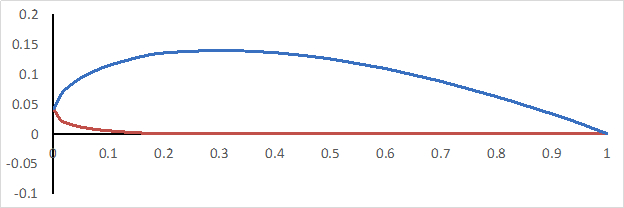Clark Y-14 Wing Performance: Deployment of High-lift Devices (Flaps and Slats)
Source: David Guo, College of Engineering, Technology, and Aeronautics (CETA), Southern New Hampshire University (SNHU), Manchester, New Hampshire
A wing is the major lift-generating apparatus in an airplane. Wing performance can be further enhanced by deploying high-lift devices, such as flaps (at the trailing edge) and slats (at the leading edge) during takeoff or landing.
In this experiment, a wind tunnel is utilized to generate certain airspeeds, and a Clark Y-14 wing with a flap and slat is used to collect and calculate data, such as the lift, drag and pitching moment coefficient. A Clark Y-14 airfoil is shown in Figure 1 and has a thickness of 14% and is flat on the lower surface from 30% of the chord to the back. Here, wind tunnel testing is used to demonstrate how the aerodynamic performance of a Clark Y-14 wing is affected by high-lift devices, such as flaps and slats.

Figure 1. Clark Y-14 airfoil profile.
- For this procedure, use an aerodynamics wind tunnel with a test section of 1 ft x 1 ft and a maximum operating airspeed of 140 mph. The wind tunnel must be equipped with a data acquisition system (able to measure angle of attack, normal force, axial force and pitching moment) and a sting balance.
- Open the test section, and install the wing on the sting balance. Start with clean wing configuration.
- Place a handheld inclinometer on the sting balance, and adjust the pitch angle adjustment knob to set the sting balance
The results of the clean wing configuration are shown in Table 1. Figures 6 - 8 show all three coefficients vs angle of attack, α, for all four configurations. From Figure 6, both the flap and slat enhanced the lift coefficient, but in different ways. Comparing the clean wing and the slat lift curve, the two curves are almost overlapping at low angles of attack. The clean wing lift curve peaks to about 0.9 at 12°, but the slat curve continues to rise to 1. 4 at 18°. This in
Lift generation can be enhanced by the deployment of high-lift devices, such as flaps and slats. Most airplanes are equipped with flaps, and all commercial transport airplanes have both flaps and slats. It is critical to characterize the performance of a wing with flaps and slats during aircraft development.
In this demonstration, a Clark Y-14 wing with a flap and a slat was evaluated in a wind tunnel. The forces and moment measurements were collected to determine the lift, drag and pitching m
- John D. Anderson (2017), Fundamentals of Aerodynamics, 6th Edition, ISBN: 978-1-259-12991-9, McGraw-Hill
Skip to...
Videos from this collection:

Now Playing
Clark Y-14 Wing Performance: Deployment of High-lift Devices (Flaps and Slats)
Aeronautical Engineering
13.0K Views

Aerodynamic Performance of a Model Aircraft: The DC-6B
Aeronautical Engineering
8.0K Views

Propeller Characterization: Variations in Pitch, Diameter, and Blade Number on Performance
Aeronautical Engineering
25.9K Views

Airfoil Behavior: Pressure Distribution over a Clark Y-14 Wing
Aeronautical Engineering
20.6K Views

Turbulence Sphere Method: Evaluating Wind Tunnel Flow Quality
Aeronautical Engineering
8.6K Views

Cross Cylindrical Flow: Measuring Pressure Distribution and Estimating Drag Coefficients
Aeronautical Engineering
15.9K Views

Nozzle Analysis: Variations in Mach Number and Pressure Along a Converging and a Converging-diverging Nozzle
Aeronautical Engineering
37.5K Views

Schlieren Imaging: A Technique to Visualize Supersonic Flow Features
Aeronautical Engineering
10.6K Views

Flow Visualization in a Water Tunnel: Observing the Leading-edge Vortex Over a Delta Wing
Aeronautical Engineering
7.6K Views

Surface Dye Flow Visualization: A Qualitative Method to Observe Streakline Patterns in Supersonic Flow
Aeronautical Engineering
4.8K Views

Pitot-static Tube: A Device to Measure Air Flow Speed
Aeronautical Engineering
48.2K Views

Constant Temperature Anemometry: A Tool to Study Turbulent Boundary Layer Flow
Aeronautical Engineering
7.1K Views

Pressure Transducer: Calibration Using a Pitot-static Tube
Aeronautical Engineering
8.4K Views

Real-time Flight Control: Embedded Sensor Calibration and Data Acquisition
Aeronautical Engineering
10.0K Views

Multicopter Aerodynamics: Characterizing Thrust on a Hexacopter
Aeronautical Engineering
9.0K Views
Copyright © 2025 MyJoVE Corporation. All rights reserved